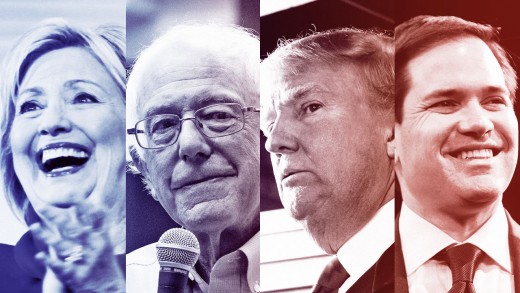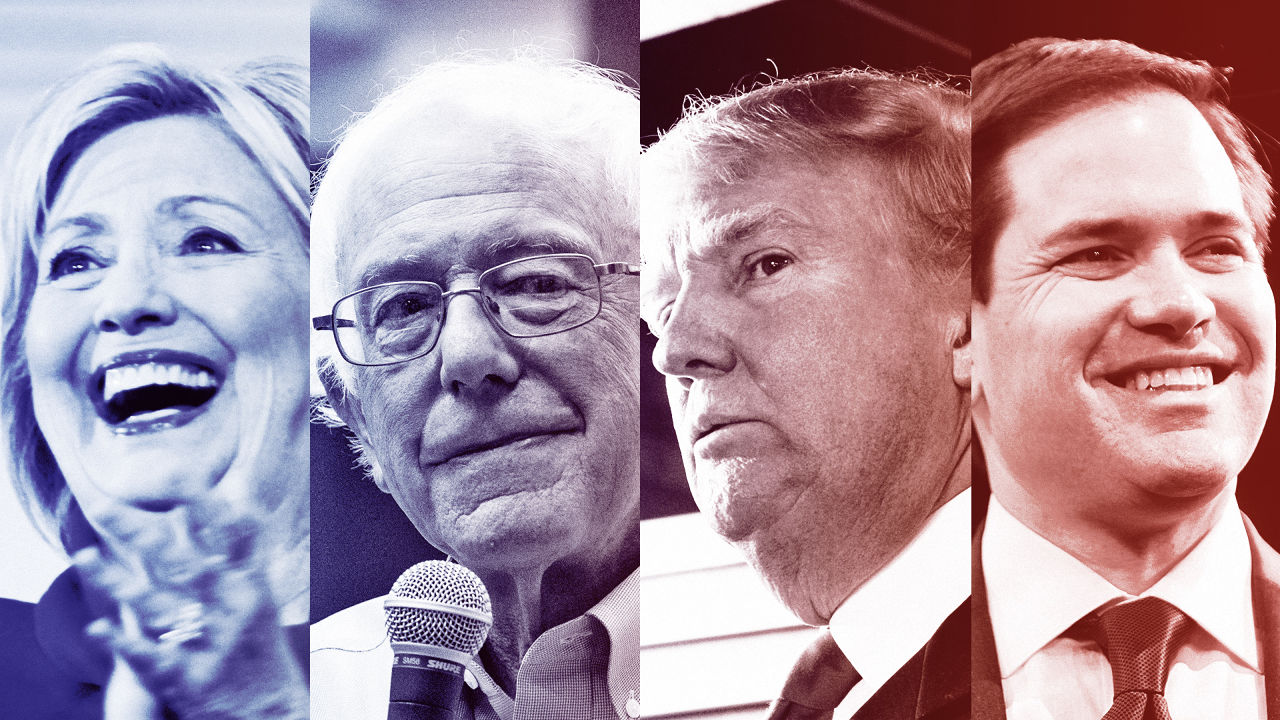an extremely Dorky have a look at each and every Presidential Candidate’s expertise Stack
the prevailing media narrative for the ultimate two U.S. presidential elections confirms what our high school math academics all the time informed us: It pays to be good to nerds.
know-how, from social media to “large information,” has develop into the brand new key to campaign success. This narrative even holds true for political pundits—some individuals now refer to data geeks like FiveThirtyEight’s Nate Silver because the “proper winners” of political elections because they began the usage of expertise and econometrics to foretell results as in the event that they were the creepy water-hostage people in Minority file.
In politics, the story now goes, the candidate who wields the most nerd weapons wins.
however now that every candidate has leapt on the digital bandwagon—in the same method that soda manufacturers and insurance coverage corporations now crowd onto hip new social platforms like Peach and Ello faster than the typical youngster—how true is the “most tech wins” speculation in 2016?

the whole scope of expertise’s position in the 2016 election received’t emerge until after the dust has settled and Donald Trump launches a reality tv express about operating the u . s .. however because the know-how parallels between political campaigning and model advertising are putting, I made up our minds to map out every of the present major candidates’ marketing know-how stacks to see how their digital strategies vary.
This is likely one of the dorkiest issues I’ve ever executed, but it was once additionally pretty fun.
here’s what the presidential martech panorama looks as if.
web page content administration
The backbone of each candidate’s digital technique is the site. (at the back of the scenes, this has created an amusing choice of pranks, including the forwarding of JebBush.com to Donald Trump’s web page.)
with out fail, these candidate homepages do three issues: solicit donations, ask for electronic mail addresses, and give an explanation for stances on political issues.
here’s what each website looks as if and what the user experience design emphasizes:

right here’s the content administration device our candidates are the use of:
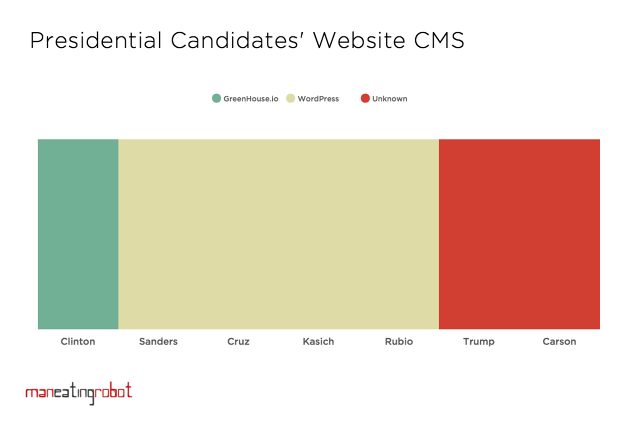
curiously, Clinton appears to use recruiting software as her content administration machine, repurposing GreenHouse as a whole CMS. It’s unclear what Carson and Trump are using to power their content, even if source code indicates that Carson is also using HubSpot (advertising and marketing automation) for his content material along with electronic mail advertising. It’s completely possible that Trump’s website is powered via his hair.
consumer monitoring
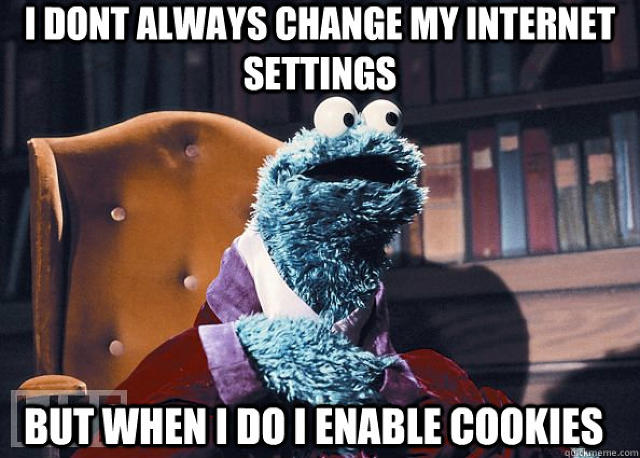
whilst you go to with regards to any web page, your visit is tracked via the web page’s owner. occasionally that site will add a “cookie” to your web browser, because of this the website online will follow a few of your process around the web or understand that you while you come again. this is why you’re regularly followed around the net with ads after you’ve visited HillaryClinton.com.
right here’s what number of monitoring technologies each candidate makes use of on you while you go to her or his website online:
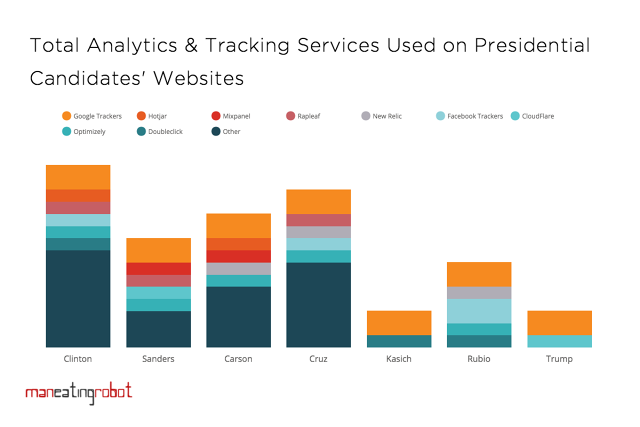
Clinton is tracking the most user knowledge of any candidate, with a complete of 14 analytics scripts working on her site. each candidate makes use of Google tracking. Optimizely (cut up testing), Mixpanel (analytics insights and conversion monitoring), and CloudFlare (who the hell is aware of?) are widespread options as smartly.
person Engagement
Political candidates want to mobilize voters and donors, getting extra people to support the lead to—simply as a client brand like Coca-Cola desires everyone to speak about Coke after they think about soda and buy Coke when they’re thirsty.
So in addition to monitoring while you talk over with their sites, candidates need you to take into consideration them as continuously as that you can think of. They need to use you as a conduit to achieve your folks too. just like Coca-Cola, political candidates use tech tools to do that.
here’s what each and every is using to regulate user engagement:

I couldn’t become aware of (with cheap accuracy) which social media administration machine every marketing campaign makes use of, however given the volume of social media job the candidates are managing, we can be fairly positive that every marketing campaign is losing $5,000 to $10,000 per thirty days on a machine like Sprinklr or Hootsuite or Tracx—apart from Mr. Trump, who is undoubtedly managing all his money owed by using hand.
I’m also going to wager that Sanders is the usage of the populist’s SMMS, Buffer, run by his granddaughter.
here are all of the merchandising systems each and every candidate has put in, in step with data from BuiltWith:
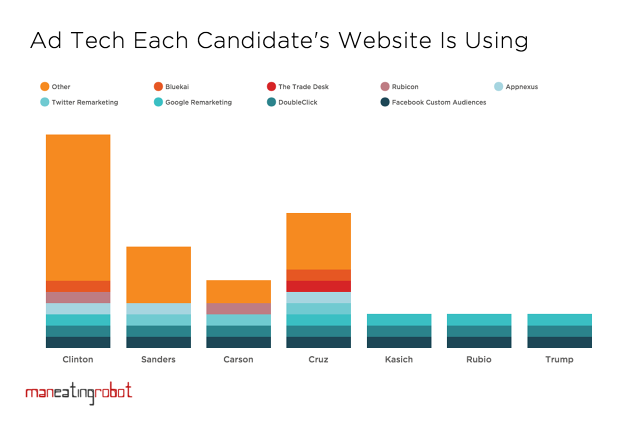
The chart above doesn’t account for the amount every candidate is spending on precise commercials, just what software they’ve put in on their web pages, which gives us an indication of the platforms they’re the use of. Carson famously declared that he was once going all-in on facebook promoting initially of his campaign. no longer a bad name given that most of the usa makes use of fb,where advertisements are low-cost. Others, like Clinton and Cruz, have opted for a “blanket the airwaves” way.
affect
I went beforehand and did some data digging on the digital influence that every candidate has at this time.
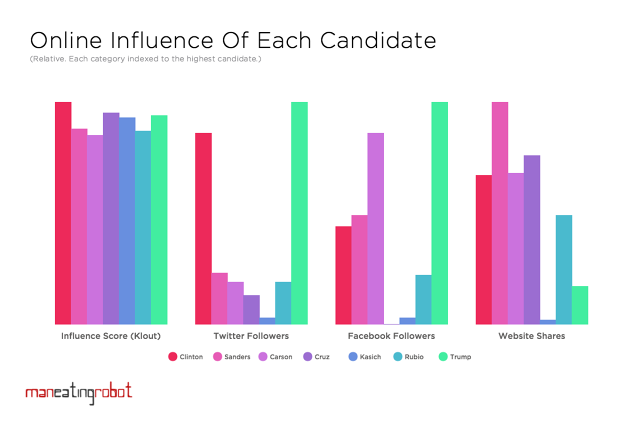
Clinton has rather extra “affect” than the remainder (consistent with how people are responding to her online content material and social media), though Trump has essentially the most followers, and Sanders has the most shared material.
external factors can considerably have an effect on a candidate’s digital influence as smartly, equivalent to when a candidate says something Twitterworthy in a televised debate. Donald Trump almost gamed the entire primary election through pronouncing so much insane stuff that he compelled the media to provide him free coverage, which the web fortunately spread.
now and again digital influence is weird or fickle, as i discovered in my contemporary diagnosis of how folks operate more Google searches for “Donald Trump’s hair” than they do for “Marco Rubio.” evaluating influence to technology isn’t necessarily pointing to causal family members, but the correlations say attention-grabbing things concerning the completely different strategies that each candidate has made up our minds to—or is able to—appoint.
There’s another thing we should point out. In pre-internet days, politicians who had get entry to to raised voter databases by the use of phone or mail tended to have a bonus over rivals. The internet afforded Obama, and now each candidate, richer tips on how to drill into that same roughly data, attaining people by the use of e mail and targeting them through web merchandising. These voter databases are gold mines, and know-how to build them, reach them, and mine them has grow to be increasingly prevalent in campaigns.
an advantage traditionally goes to the candidate who can accumulate and leverage probably the most proprietary knowledge. each and every candidate presumably has her or his personal database of supporter knowledge in addition to get right of entry to to the political celebration’s database.
What’s fascinating here just isn’t the real database technology—which doesn’t seem to vary all that much—however the instruments candidates put in the back of it. in case you think of volunteers and field group of workers as little cookie collectors going door to door accumulating data to plug into the greater database, the instruments becomes an immense deal for campaigns for the reason that more cash you set into analog information collection, the more powerful your technology can be.
in all probability the lesson for the remainder of us boils all the way down to one of the vital ideas that data geeks talk about: rubbish in, rubbish out. Your technology is best going to be as good as what you place into it. in case you’re a content marketer with great tech however little content, you’re more than likely going to lose to the competitor with equal or even worse tech however amazing content.
I’m not pronouncing that Trump’s content material is superb, but he’s fueling his moderately lightweight technology stack with highly original content material (speeches, talking points, and many others.) targeted at very explicit teams—in his case, offended and checked-out voters. For better or worse, Trump’s content hits all the necessities for “shareability” that I write about here and has yielded giant results compared to other candidates with boring content material. Hillary, who’s polling the absolute best of all the candidates at the moment, has moved far from her traditionally polarizing solution to politics, so her use of technology (and massive ad budgets) might just be what’s serving to her keep within the conversation.
I won’t entrance like a clairvoyant and predict which candidate will win in the end. loads goes to happen earlier than election day. however i am comfy announcing at this time that one of the most biggest winners of this election—and almost definitely many future elections—would be the device firms promoting to everybody. In a battle with many opponents and escalating weaponry, it can pay to be an hands seller.
this text was once at the beginning revealed at Contently’s The content material Strategist. Shane Snow is an award-successful journalist and cofounder of Contently. in the event you favored this put up, subscribe to his blog, ManEatingRobot, by the use of e-mail, or get a free chapter of his bestselling ebook.
related: will have to fb Censor Trump?
(20)

